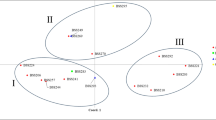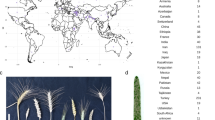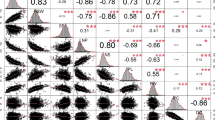Abstract
The main purposes of the study were (i) to develop a mapping population, (ii) to construct its genetic map for further identification of genes associated with important agronomic traits. To the best of our knowledge this is the first segregating population and genetic map developed for Kazakh bread wheat. The work is an example of how plant breeding programs in Kazakhstan have started successfully using next generation plant breeding methods to carry out systematic plant breeding to enhance final grain harvest. The KASP technology and SNP DNA-markers have been exploited to genotype and build a genetic map. The total length of the map was 1376 cM. A total 157, which spanned A, B and D subgenomes, out of the initial 178 SNP markers used formed 26 linkage groups leaving 1 duplicated and 20 unassigned markers. As threshold distance between markers was set ≤30 cM, two linkage groups were obtained for chromosomes such as 2А, 2В, 2D, 3A, 5A, 6B and 7A. Kosambi mapping function was employed to calculate recombination units. RILs were developed through SSD method up to F4 generation. Almost 97% of identified alleles were useful in evaluating the population’s genetic diversity; the remaining 3% showed no outcome. As a result, 77 DNA markers were mapped for A, 74 for B and 27 for D genomes. The mapping population will be genotyped using a high marker density array platform such as Illumina iSelect to obtain a genetic map with a relatively high coverage. Then, the population and high-resolution genetic map will be used to identify genes influencing wheat adaptation in Kazakhstan.







Similar content being viewed by others
REFERENCES
Smith, C.W., Crop Production: Evolution, History, and Technology, Wiley, 1995.
Nesbitt, M., and Samuel, D., Wheat domestication: archaeobotanical evidence, Science, 1998, vol. 279, no. 5356, pp. 1431.
Gustafson, P., Raskina, O., Ma, X., and Nevo, E., Wheat evolution, domestication, and improvement, Wheat Sci. Trade, 2009, vol. 29, pp. 5—30.
Wang, J., Luo, M. C., Chen, Z., et al., Aegilops tauschii single nucleotide polymorphisms shed light on the origins of wheat D-genome genetic diversity and pinpoint the geographic origin of hexaploid wheat, New Phytol., 2013, vol. 198, no. 3, pp. 925—937.
Feldman, M., Liu, B., Segal, G., et al., Rapid elimination of low-copy DNA sequences in polyploid wheat: a possible mechanism for differentiation of homoeologous chromosomes, Genetics, 1997, vol. 147, no. 3, pp. 1381—1387.
Bushuk, W., Wheat breeding for end-product use, in Wheat: Prospects for Global Improvement, Springer-Verlag, 1997, pp. 203—211.
Eken, C., Spanbayev, A., Tulegenova, Z., and Yechshzhanov, T., First report of Nigrospora oryzae on wheat in Kazakhstan, Plant Dis., 2016,vol. 100, no. 4, pp. 861—861.
Swinnen, J., Burkitbayeva, S., Schierhorn, F., et al., Production potential in the “bread baskets” of Eastern Europe and Central Asia, Global Food Secur., 2017, vol. 14, pp. 38—53.
Anuarbek, S., Abugalieva, S., Тuruspekov, Y. Assessment of the genetic diversity of durum wheat cultivars (Triticum durum Desf.) using microsatellite markers, Experimental Biology, vol. 74, no. 1, pp. 88–98.
Abugalieva, S., Volkova, L., Ermekbaev, K., and Turuspekov, E., Genotyping of commercial cultivars of spring bread wheat from Kazakhstan by microsatellite DNA-markers. Biotech. Theory Pract., 2012, vol. 2, pp. 35—45.
Turuspekov, Y., Plieske, J., Ganal, M., et al., Phylogenetic analysis of wheat cultivars in Kazakhstan based on the wheat 90 K single nucleotide polymorphism array, Plant Genet. Resour.—Charact. Util., 2017, vol. 15. no. 1, pp. 29—35. https://doi.org/10.1017/s1479262115000325
Turuspekov, Y., Baibulatova, A., Yermekbayev, K., et al., GWAS for plant growth stages and yield components in spring wheat (Triticum aestivum L.) harvested in three regions of Kazakhstan, BMC Plant Biol., 2017, vol. 17, no. 1, p. 190.
Turuspekov, Y., Ormanbekova, D., Rsaliev, A., and Abugalieva, S., Genome-wide association study on stem rust resistance in Kazakh spring barley lines, BMC Plant Biol., 2016, vol. 16. no. 1, p. 6.
Genievskaya, Y., Almerekova, S., Sariev, B., et al., Marker-trait associations in two-rowed spring barley accessions from Kazakhstan and the USA, PLoS One, 2018, vol. 13, no. 10. e0205421
Almerekova, S., Sariev, B., Abugalieva, A., Chudinov, V., Sereda, G., Tokhetova, L., Ortaev, A., Tsygankov, V., Blake, T., Chao, S., Genievskaya, Y., Abugalieva, S., Turuspekov, Y. Association mapping for agronomic traits in six-rowed spring barley from the USA harvested in Kazakhstan, PLoS One, 2019, vol. 14, no. 8. e0221064.
Ashimova, A., Yermekbaev, K., Turuspekov, Y., and Abugalieva, S., Genotyping the world oat collection using microsatellite markers, Exp. Biol., 2016, vol. 66, no. 1, pp. 134—143.
Tee, T.S. and Qualset, C., Bulk populations in wheat breeding: comparison of single-seed descent and random bulk methods, Euphytica, 1975, vol. 24, no. 2, pp. 393—405.
Fischer, R. and Rebetzke, G., Indirect selection for potential yield in early-generation, spaced plantings of wheat and other small-grain cereals: a review, Crop Pasture Sci., 2018, vol. 69, no. 5, pp. 439—459.
Broman, K. W., The genomes of recombinant inbred lines, Genetics, 2005, vol. 169, no. 2, pp. 1133—1146.
Ren, J., Wang, Z., Du, Z., et al., Detection and validation of a novel major QTL for resistance to Fusarium head blight from Triticum aestivum in the terminal region of chromosome 7DL, Theor. Appl. Genet., 2019, vol. 132, no. 1, pp. 241—255.
Swarcewicz, B., Sawikowska, A., Marczak, et al., Effect of drought stress on metabolite contents in barley recombinant inbred line population revealed by untargeted GC–MS profiling, Acta Physiol. Plant., 2017, vol. 39, no. 8, p. 158.
Jukte, S.R., Marker assisted selection for conferring resistance against Fusarium oxysporum f. sp. Ciceris in Chickpea, Dissertation, India: Post Graduate Institute, Department of Plant Pathology, 2017.
Grunvald, A.K., Torres, A.R., Passianotto, A.L.d.L., et al., Identification of QTLs associated with biological nitrogen fixation traits in soybean using a genotyping-by-sequencing approach, Crop Sci., 2018, vol. 58, no. 6, pp. 2523—2532.
Pan, Q., Xu, Y., Li, K., et al., The genetic basis of plant architecture in 10 maize recombinant inbred line populations, Plant Physiol., 2017, vol. 175, no. 2, pp. 858—873.
Wingen, L.U., West, C., Leverington-Waite, M., et al., Wheat landrace genome diversity, Genetics, 2017, vol. 205. no. 4, pp. 1657—1676.
Wilkinson, P.A., Winfield, M.O., Barker, G.L., et al., CerealsDB 2.0: an integrated resource for plant breeders and scientists, BMC Bioinf., 2012, vol. 13, no. 1, p. 219.
Heffelfinger, C., Fragoso, C.A., and Lorieux, M., Constructing linkage maps in the genomics era with MapDisto 2.0, Bioinformatics, 2017, vol. 33, no. 14, pp. 2224—2225.
Kosambi, D.D., The estimation of map distances from recombination values, in D.D. Kosambi, Ramaswamy, R., Ed., New Delhi: Springer-Verlag, 2016, pp. 125—130. https://doi.org/10.1007/978-81-322-3676-4_16
Broman, K.W., Genetic map construction with R/qtl, University of Wisconsin-Madison, 2010. http://www. rqtl.org/tutorials/geneticmaps.pdf.
Ihaka, R. and Gentleman, R., R: a language for data analysis and graphics, J. Comput. Graphical Stat., 1996, vol. 5, no. 3, pp. 299—314.
Voorrips, R.E., MapChart: software for the graphical presentation of linkage maps and QTLs, J. Hered., 2002, vol. 93, no. 1, pp. 77—78.
Funding
We really thank funding bodies:
(1) ADAPTAWHEAT (289842) funded by EU 7th Framework Programme for Research and Technological Development.
(2) The grant 1784/GF4 funded by Ministry of Science and Education of Republic of Kazakhstan.
(3) The “BOLASHAK” International Presidential Scholarship of the President of the Republic of Kazakhstan.
Author information
Authors and Affiliations
Corresponding author
Ethics declarations
The authors declare that they have no conflict of interest. This article does not contain any studies involving animals or human participants performed by any of the authors.
Rights and permissions
About this article
Cite this article
Yermekbayev, K., Griffiths, S., Chhetry, M. et al. Construction of a Genetic Map of RILs Derived from Wheat (T. aestivum L.) Varieties Pamyati Azieva × Paragon Using High-Throughput SNP Genotyping Platform KASP—Kompetitive Allele Specific PCR. Russ J Genet 56, 1090–1098 (2020). https://doi.org/10.1134/S102279542009015X
Received:
Revised:
Accepted:
Published:
Issue Date:
DOI: https://doi.org/10.1134/S102279542009015X




